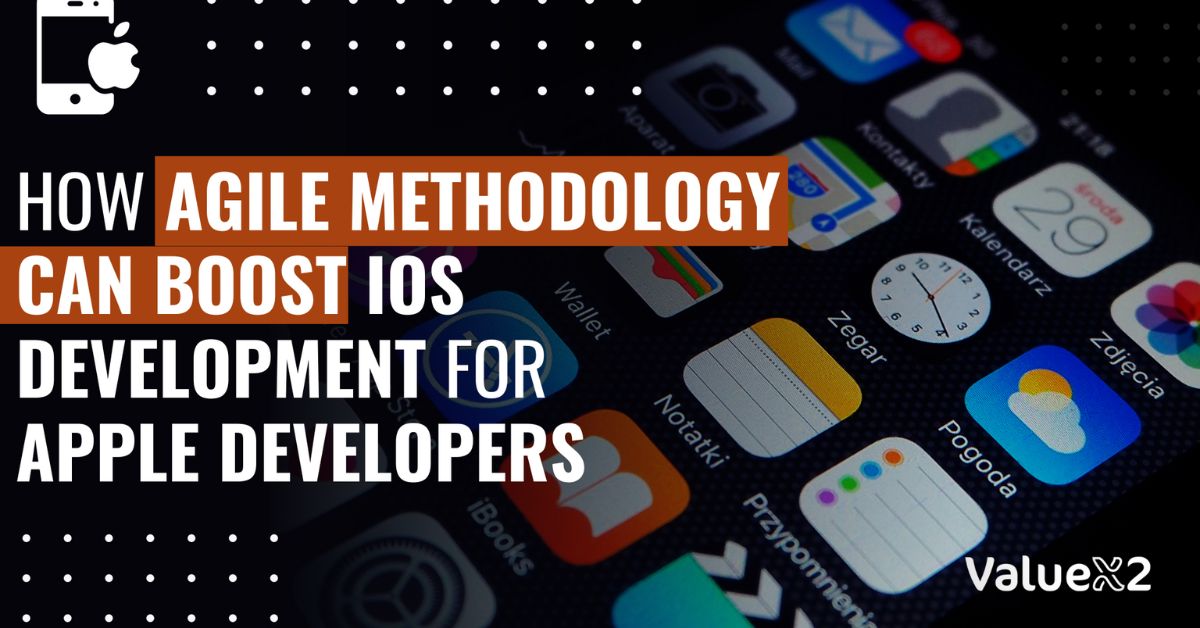Want to know how you can unlock faster iOS development with Agile methodology? Learn how Agile Methodologies boost iOS Development by increasing flexibility, boosting team collaboration, and delivering high-quality apps that outpace the competition.

When handling competition, having a kind of approach that enables developers to be discerning about change is important. Agile software is seemingly evolving in an unpredictable fashion. This is where agile methodology comes in.
The traditional methodologies tend to create problems due to their rigidity and formality. Agile methodologies provide a more informal and flexible form of framework that is easier to execute. Agile method development for iOS is no longer a privilege; rather, it has become necessary because it keeps developers ahead through this agile methodology that lets deliver more high-quality apps from Agile methodology in time-to-market than ever before. The secret here is how it will completely transform your app-building process.
What is Agile Methodology? A Layman’s Guide
Agile is not just a term; it is a mental attitude. It does not work exactly like traditional Waterfall in the step-by-step tradition, but Agile is somehow flexible, iterative, and adaptive.
Key Components of Agile for iOS:
- Sprints: Small, manageable development cycles that are usually 1 to 4 weeks.
- Backlogs: Moving lists of priorities to first tackle what matters most.
- Continuous Feedback Loops: Ensure that the user insights are helpful in every step.
Agile’s incremental improvement focus makes it the perfect ally for developing iOS where Apple’s updates and market demands are continually evolving. Agile divides the development process into several smaller periods known as sprints for you to be more flexible. This makes it easier for the developers to effect changes since they get to provide better-quality software. In fact, every sprint has specific objectives to accomplish and at the end of a sprint, there are enhancements and updates in the software.
How Can Agile Improve Your iOS Development Process?
In the current mobile application development, especially with iOS, Agile software development methodologies help the development groups fulfil the ever-changing requirements of both technology and the clients in an efficient manner. Here’s how Agile practices can enhance your development workflow:
I. Quick Development and Faster Time-to-Market Cycle
Agile divides large projects into short sprints that are easily manageable. This in turn enables the iOS developers to produce working software as fast and often as they can. With Agile practices, you can do updates during the processing stages contrary to traditional methods. This makes it possible to release new features and improvements more often to meet the market demands and competition.
II. Improved Product Quality
Integration and specifically testing are integral activities in Agile since the processes are repetitive. Developers can spot and fix bug-related problems in the iOS application’s progress when they test features at the end of each sprint. The process is continuous as a way of making quality improvements to its development phase and during its marketing phase.
III. Enhanced Adaptability to Change
iOS development gets its update from time to time depending on the feedback received from the users, changes in the platform and the trends in the market. Agile also guarantees that the teams can implement those alterations without affecting the whole project. Agile also makes the process proven with timely and effective changes, ensuring things like incorporating new iOS features or adding to the feedback received from the users.
IV. Increased Customer Satisfaction
It focuses a lot on the consumers throughout the development process as evidenced in Agile. Regular testing and gathering user feedback guarantee the app’s conformity to user’s expectations. Such a system produces a product that is desirable to the users hence enhancing satisfaction rates among the consumers.
V. Stronger Team Collaboration
This is because agile encourages the integration of cross-functional teams including the developers, designers and product owners. Scrum meetings such as daily scrum, sprint review, and retrospectives foster transparency and enhance the identification of problems which would have taken time to be identified on their own were not to be held. This is common especially when dealing with top-down approaches which eradicate the aspect of having people in different small compartments.
VI. Real-World Impact: Faster Updates, Happier Users
For better understanding, picture this: Instead of two months for such an overhaul, getting a new feature to production like Dark Mode within just two weeks. Agile makes pushing updates much faster without frustrating users.
VII. Reduced Risk and Cost
Another advantage of Agile is that instead of developing large changes which can cause unexpected problems, it provides small changes which can cause potential problems in the development cycle. The amount of correction work to be done is reduced. This is because several issues that may culminate into major complications in the future are eliminated at an early stage. Agile’s constant usage of testing and receiving feedback from the user also minimizes the likelihood of the project deviating from the right track.
Key Agile Practices for iOS Developers
Below are the key Agile practices that iOS developers can integrate into their workflow:
- Sprints: Sprints are short development iterations that take 1-4 weeks with the main aim of providing a set of enhancements. iOS developers know that sprints disassemble large projects into appropriate small tasks helping to release apps more often and adapt to changing conditions faster.
- Daily Stand-ups: The team synchronizes their work and ensures every member knows what has been done, what currently hinders progress, and what actions will be taken in the near future.
- Backlogs: A product backlog is a list of upcoming work that may consist of new functionalities, enhancements, or removal of defects.
- Continuous Integration (CI): CI entails integrating code into a common repository with subsequent action being built and tested. This practice enables the iOS teams to identify the challenges that are associated with the conflicts and offer a solution to them while ensuring that they work on a stable code base while at the same time issuing frequent updates.
- Testing: Regular testing from time to time such as unit tests and user interface tests helps the developers in checking the quality of their code all the time. This is because the integration of continuous testing offers quick feedback for the iOS developers. The bug that is identified can easily be rectified as the job continues.
- Retrospectives: Self-assessment is done in the form of a retrospective meeting at the end of each sprint to discuss on what needs to be changed. Retrospectives make things improve and improve processes regularly and bring out the results in terms of better coordinated and performing teams.
This way, the iOS developers could benefit from the Agile practices that would introduce productivity and cooperation, as well as the high-quality app that could be delivered most efficiently.
Some Not-So-Obvious Agile Practices That Will Make You a Pro
1. Mob Programming
You have probably heard of the whole team working on the same piece of code. Mob programming is exactly that, it sounds unusual, but team collaboration leads to cleaner and fewer bugs in the code.
2. Kanban for iOS
While everyone’s talking about Scrum with Agile, Kanban, through boards, can change the game for solo developers of iOS or even smaller teams.
3. Continuous Deployment
Do not update it yourself! Tools like Bitrise will automatically deploy to the App Store after each sprint. It’s a niche but mighty Agile practice for iOS.
4. Feature Toggles
Roll out features in your app that users haven’t seen yet. Flip them on when ready and thus deploy safely and incrementally.
Case Study: Agile at Spotify
At Spotify, the iOS team improved the personal playlists of their app by making good use of Agile. Continuous and constant short sprints were a success through which they built up some of the features of interest which included Blend and Wrapped into overnight favourites.
How ValueX2 Can Help You Implement Agile
Here at ValueX2, we have gained experience in guiding individuals on the effective implementation of Agile methodologies in their organizations. This includes guidance, training, and tooling for the organization during its transformation. We offer agile-related courses, wherever you go these certifications are globally known and accepted.
Getting Started with Agile
ValueX2 emphasizes three core practices to get your Agile journey off the ground:
- Setting Clear Goals: We assist in defining the vision and goals of your project from the initial stage.
- Sprint Planning: Our team helps you plan how to divide your project into shorter and more productive cycles that will engage the team.
- Regular Feedback Loops: Users and stakeholders provide continuous feedback to ensure that each release adds value and aligns well with expectations.
How ValueX2 Can Help Enable Agile Implementation
ValueX2 provides comprehensive support to ensure Agile practices are integrated effectively:
- Expert Training: Get trained by experienced Agile practitioners through customized training programs.
- Tailored Solutions: Receive tailored consulting to apply Agile principles to suit your specific project needs.
- Proven Methodology: Adopt a strategy that has been used by various organizations and teams to adopt the Agile method.
Tools and Resources
To ensure success, ValueX2 offers:
- Training Courses: To obtain a basic understanding of Agile principles and effective practices.
- Consulting Services: Consult with professionals who will help you deal with any issue and enhance your Agile frameworks.
- Agile Tools: Access resources designed to facilitate and support Agile workflows.
ValueX2 helps you not only adopt Agile but also transforms your development cycle to enhance collaboration, productivity, and adaptability.
Our Closing Statements
Now that you know how Agile methodologies boost iOS development, this approach will help you not just in terms of efficiency but will help you stand out for creating apps that are truly remarkable. Agile is known to empower developers to create faster, respond to the user’s feedback in real-time, and continuously improve, keeping the flexibility and adaptability of the whole development process. Agile always gets you moving ahead of the curve, with Agile, you design high-quality user-centric applications that win customer loyalty and outperform competitors. All this translates to results of faster releases, higher customer satisfaction, and keeping the competitiveness at the top.
Want to inspire the power of Agile in your team? ValueX2 has all the knowledge and tools that would help in driving a successful implementation of Agile in iOS projects. During hands-on training, we teach strategies capable of raising productivity for teams by as much as 30%.
Don’t let this opportunity pass; Register now!
Frequently Asked Questions (FAQs)
Q: What is the difference between Agile and Waterfall?
A: Agile is iterative and flexible, allowing for continuous improvement and feedback. Waterfall, by contrast, is a linear-sequential approach. Generally, in dynamic projects such as iOS app development, Agile is the preferred approach to take.
Q: How does ValueX2 support a successful Agile implementation by my team?
A: ValueX2 offers professional-led training and consulting to onboard your team into Agile, providing hands-on strategies and customized solutions that help you increase productivity and app quality.
Q: Why should I take the course on Agile by ValueX2?
A: ValueX2 provides customized training by practitioners with years of experience, purely pragmatic, based on the knowledge of Agile principles, to apply effectively the model and bring fast quality app development.
Q: What are some challenges in the implementation of Agile, and how will ValueX2 add any value to it?
A: These challenges may be slipping into the new workflows and managing the sprints. ValueX2 supports consulting and training to overcome these obstacles for fine-tuning Agile.
Q: Can the Agile training by ValueX2 be useful for projects ranging from small to large-scale iOS projects?
A: Yes, Agile training by ValueX2 is scalable to project size, making sure that Agile principles and practices are worked out not only on small projects but also on the biggest ones.

Bhavna is an Agile Coach and Consultant with 15+ years of experience in advisory, corporate finance, IT assurance, and operations at Big 4 and within the industry in the UK and India. She has recently been the CEO of a start-up where she implemented agile practices within HR, Marketing, and Product teams.
She is also a SAFe® Practice Consultant (SPC) and authorized instructor for ICAgile Agility in HR (ICP-AHR), Agility in Marketing (ICP-MKG), and Business Agility Foundations (ICP – BAF) training courses. She provides training for agile transformation to corporate, public, and private batches, as well as consulting for enterprise agile transformation.






